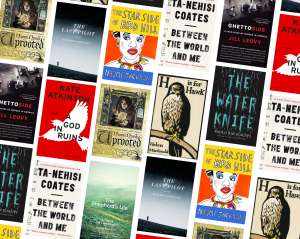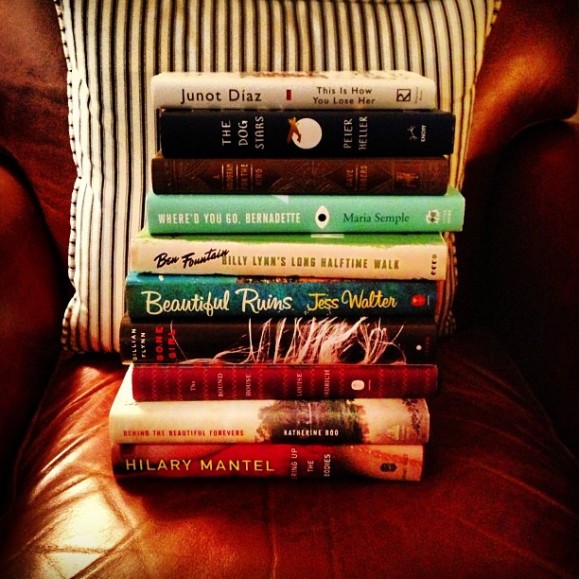LINCOLN IN THE BARDO by George Saunders is a novel about President Lincoln coming to terms with the death of his 11-year-old son in the midst of the Civil War. The narrative is conveyed through two distinct threads. The first features the voices of the ghosts of Oak Hill Cemetery where Willie is buried, who collectively form a kind of Greek chorus. The second is a collection of excerpts from primary documents, diaries, and analysis from historians writing about the era. It’s like nothing else you’ve ever read, with imagery and ideas that linger on in your imagination well after you’ve turned the final page. It’s a piece of writing from Saunders, so there’s humor here — but mostly, this is a careful, empathetic study of grief and missed opportunity. http://amzn.to/2zkRqSl
KILLERS OF THE FLOWER MOON by David Grann is the best piece of nonfiction I read in 2017. It’s a story about the Osage Tribe in southeastern Kansas. Because they managed to hold onto their mineral rights while negotiating land treaties with US government, they became some of the richest people in the world during America’s first big oil boom in the 1920s. Then, the killings started. Some members of the tribe were shot. Some were poisoned. At least one house was bombed with dynamite. All those crimes remained unsolved until one of the first agents in the newly-formed Federal Bureau of Investigation was tasked with the case. The answers he found remain dark, chilling, and incredibly relevant in our current political climate. http://amzn.to/2DBb7bP
MY ABSOLUTE DARLING by Gabriel Tallent is a beautiful piece of literature that unfolds with the rhythms of a horror film. The hero is a 14-year girl named Turtle Alveston. The monster is her father, Martin. There’s no escaping the fact that this is a story about abuse — emotional, physical, and sexual. Martin Alveston is convinced that societal collapse is just around the corner, the inevitable result of an impending environmental apocalypse. He doesn’t so much raise his daughter as he does train her — how to break down and reassemble an assault rifle, how to amputate a splintered finger, how to measure her self-worth by the amount of pain she can endure. Given the brutal state of her home life, it’s no surprise that Turtle finds refuge in the natural world, and the Northern California landscapes are a driving force in this novel, nearly a character in their own right. On one trek, she meets a pair of teenage boys, and the friendship they strike gradually pulls Turtle out of her isolation. The conclusion is tightly plotted, and the inevitable confrontation between Martin and Turtle has a cinematic quality which, even weeks after putting it down, I found difficult to get out of my mind. http://amzn.to/2BZTLYe
MAGPIE MURDERS by Anthony Horowitz is a send-up to the classic detective story. In the first chapter, we learn that we’re about to read the final novel by the most popular mystery writer in the world, which was delivered to his publisher just before he took his own life. You launch into the manuscript — which is a pitch-perfect, post-WWII British countryside murder mystery. And then you realize that the last chapter is missing — you’re left not knowing who actually committed the crime in the novel within the novel. Then, you’re back with the dead author’s literary agent as she sets out to find what happened to the missing conclusion. And as she begins to ask questions, you realize that maybe the author’s death wasn’t a suicide after all. The whole thing is clever and delightful. http://amzn.to/2D4ay9o
THE POWER by Naomi Alderman is a piece of speculative fiction that imagines a moment in the very near future when girls suddenly exhibit the ability to discharge a deadly electric shock from their bodies. As women throughout the world begin to exercise this power, the result is a fundamental and irreparable upheaval of societal dynamics. Governments collapse, prophets emerge, and the basic tenants of civilization begin to realign. Alderman tells the story from the perspective of four very different protagonists — observing (or influencing) events across the globe — and each of their stories is gripping. Early on, one of those characters tells us that, “transfers of power, of course, are rarely smooth” — and the rest of the book sets about proving that point. http://amzn.to/2zlZBh8
THE LAST COWBOYS OF SAN GERONIMO by Ian Stansel is a modern Western. In the opening pages, Silas Van Loy kills his older brother, Frank, then heads into the hills of Northern California on horseback. His sister-in-law, Lena, sets off in pursuit. As the chapters alternate back and forth, we learn the backstories of all these characters — how the brothers inherited a horse training operation from their father, then adapted the stables to meet the wants of the changing demographics of Marin County. We learn about the rivalry, which propels them to success but poisons their relationship. And we learn about the way of life that connects them to each other. From start to finish, this story is a quick-moving 208 pages, and there’s not a wasted word. http://amzn.to/2D40QUz
MANHATTAN BEACH by Jennifer Egan is a timeless, almost-old-fashioned piece of historical fiction from a thoroughly-modern writer. It’s 1942 in New York City, and the Brooklyn Navy Yard is fully mobilized in support of the war effort. Anna Kerrigan has a job inspecting component parts destined for battleships and freighters. Dexter Styles is a gangster, running night clubs for a crime boss. Anna dreams of becoming a diver, and Dexter wants to go legit. She finds more success than he does, and soon, she’s one of the first women in the Navy to wear the 200-pound suit of rubberized canvas and slip beneath waves to lead salvage operations and conduct repairs. As you might guess about a book where characters are constantly moving between the surface and the seafloor, perspective is deeply important to the narrative. Events viewed a particular way by one character look radically different to another, and readers will find disparate themes in this story as well. For one, this will be a war novel; for another, a coming of age story; for yet another, a piece of noir. But because it’s Egan, it’s all of those things — and it works. http://amzn.to/2DBU5tW
SING UNBURIED SING by Jesmyn Ward is a ghost story. Jojo is a 13-year-old black boy, living with his grandparents in Mississippi, helping to raise his three-year-old sister, Kayla. Leonie is their mother, wrestling with a drug habit. Jojo and Leonie are each haunted by souls with connections to their family’s past. When the children’s white father is granted parole from Parchman penitentiary, the three set off to collect him, their respective ghosts along for the ride. While that road trip delivers its share of physical calamities, the true tension for these characters is a product of their need to reckon with history. Late in the book, one character tells another, “We don’t walk no straight lines. It’s all happening at once. All of it.” That idea is essential for understanding Ward’s view of our world — the past lingers on in our lives, and there’s no escaping it. http://amzn.to/2Brv4QX
THE ESSEX SERPENT by Sarah Perry is a novel defined by its boundless self confidence. It’s fully aware of the tradition in which it exists — the Victorian romance — but is modern and lively enough to defy expectations of that genre wherever it wants. Freed from a loveless marriage by the untimely death of her husband, Cora Seaborne decides to explore her passions for the physical world. She leaves London and sets off for the marshes and shorelines of southeast England, hunting for fossils. There she catches wind of a local legend about a giant, perhaps prehistoric, serpent. She also meets Reverend William Ransome and his wife, Stella. Both monster and vicar become sources of fascination. This is a book that finds space for scores of love triangles, questions of faith, medical drama, and natural philosophy — without ever feeling cramped or hurried. http://amzn.to/2l4507n
AMERICAN WAR by Omar al Akkad is about a second civil war in the United States, set in the closing decades of the 21st century. As the impacts of climate change become more severe, the federal government bans the use of fossil fuels. Louisiana, Arkansas, Tennessee, and South Carolina secede from the union. Soon, weaponized drones are patrolling border areas, suicide bombers are attacking government buildings, and refugee camps become recruitment centers for both sides of the conflict. While the book wrestles with big-picture, geopolitical questions, there’s a single family at its center. As we watch twin sisters Sarat and Dana, their brother Simon, and their mother Martina navigate a path through this world, the tragedy of this possible future gains weight and becomes tangible. It’s a piece of post-apocalyptic fiction that feels all too present. http://amzn.to/2D3BwxD

